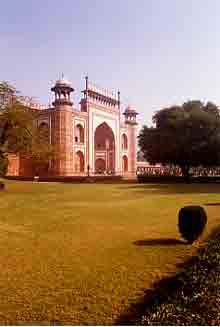|
 The gate to the courtyard of the Taj Mahal The gate to the courtyard of the Taj Mahal
|
|
If there's another building as well known as the Taj Mahal, I can't think what it is. All my life I've se en pictures of this remarkable structure, one of the true wonders of the world.
Once we landed in Mumbai and began to plan our overland journey, we knew we had to go there, there being the city of Agra, 120 miles south of Delhi, on the banks of the Yamuna River. We purchased train tickets (one of those "simple" acts that in India can consume an entire day and leave you confused, addled, bemused and suicidal).
And, in fact, our departure the next day proved our fears were right. We got to the train station platform early and waited for two hours fending off beggars and touts. When the Rajdhani Express pulled in we hunted for our car, selected one that looked close to the scrawlings on our tickets, climbed aboard and found none of the compartments matched our numbers. Of course this gave us opportunity to practice hyper ventilating and blood pressure spikes.
Fortunately one of the many conductors was also on board and he took our tickets and pointed out that we were on the waiting list. Waiting list! I'd paid a small fortune to get on this train, and was told by the General Manager of the Station himself that everything was OK. He patiently listened to my whimpering
|
|
|
|
and sniveling and asked me to come with him--leaving family and packs on the car while we fast marched back into the heart of the station.
Sure enough, there we were listed, confirmed seats on the waiting lists. But we found these only after three terrified scans of the list. He took me back to my family like a kindly patrol officer returning a lost boy to his home, and helped us find the right car and compartment where we promptly settled in like Robinson Carruso finding a sandy beach and a washed up six pack of cold beer.
We rode all night and arrived in Delhi the following morning, quickly hired a car and driver and rode the next 6 hours south to Agra. And as the magic of our journey would have it, we arrived in time for the New Year celebrations. From my journal:
"December 31--We stay in a hotel with all the advantages--nice bungalows, a court yard and pool, unlimited manpower--yet it's shabby and unkempt. People everywhere, men entirely, standing to do work. But no work is done except the endless obsession of how to relieve you of your money. Clean a window? mend a drape? sweep a floor and polish the tiles? Hell no, not necessary, not my station. I'll have my "boy" do it."
On the first day of the new year we rode to the entrance of one of the world's great marvels, fought our way through mobs of evil-eyed touts and pick pockets, walked into the outer court yard, stood in line, and then entered the large gates.
And there it was. No picture can prepare you. No National Geographic special can convey how utterly breathtaking it is in reality. For one, it's much larger than I ever imagined. Its perfection of form and balance, long discussed, is no match for how it plays its image on your neurons and makes you want to sit and stare. And no wonder, after all its purpose was to honor Love.
The fifth (and next to last) Mughal Emperor, Shah Jahan (1627-1658) was crushed by the death of his favorite wife, Mumtaz who he had been married to for 17 years. She died in childbirth, 1631, after producing for the Shah 14 other children. For the next 23 years the Shah directed the massive undertaking of building her tomb, the Taj. It required over 20,000 workers from all over India and Europe, and designers from as far away as the Middle East and Europe.
The Shah built his monument, had Mumtaz permanently transferred there, and began plans for his own eternal tomb, the "Black Taj," a kind of mirror image of her lasting memory. However, his son, Aurangzeb Shah Jahan, sons being what they are, killed off his brothers, kept his fingers crossed behind his back, and swept into the palace while dear dad was planning how to finance his next move. Dad was relieved of duties while the son became the last Mughal emperor of the empire, throwing dad in an especially built cell about the size of the Houston Astrodome, with a few windows facing the Taj.
The Taj, this massive and perfectly carved monument, despite all the centuries, has rested on a foundation of loosely packed sands along a shallow river. But in the last two decades industrial pollution from several nasty plants nearby has done more damage than all the defacing maniacs.
Each year, hundreds of thousands of people make the pilgrimage to see the Taj. It's one of the strangest parts of this man-made phenomenon, it's so large that each day thousands of visitors become only small dots on a vast plain of white, and each visitor can find their own corner in which to meditate
|
|